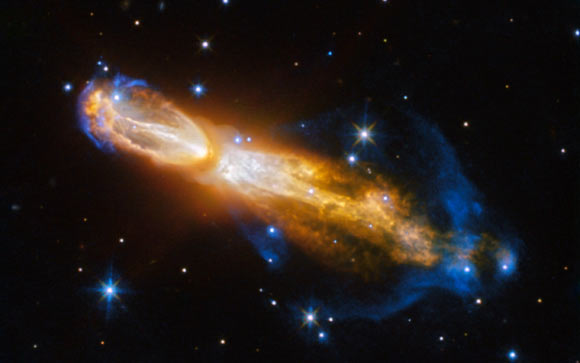A stunning new image of a little-known protoplanetary nebula, the Calabash Nebula, has been captured by the NASA/ESA Hubble Space Telescope.

This Hubble image shows the Calabash Nebula, which lies in the constellation of Puppis, about 5,000 light-years away. Image credit: NASA / ESA / Hubble / Judy Schmidt, www.geckzilla.com.
This new image from Hubble shows a once-normal star going through a rapid transformation from a red giant to a planetary nebula, during which it blows its outer layers of gas and dust out into the surrounding space.
Astronomers rarely capture a star in this phase of its evolution because it occurs within the blink of an eye — in astronomical terms.
Recent observations have found many unusual molecules in the gas around the central star, including many containing sulfur, such as hydrogen sulfide and sulfur dioxide.
These sulfur compounds are believed to be produced in the shock waves passing through the gas.
Because of the large amount of sulfur compounds, this object has earned the nickname the Rotten Egg Nebula.
The object is also known as the Calabash Nebula or by the technical name OH 231.8+04.2.
It is located in the constellation of Puppis, roughly 5,000 light-years away from us, and is approximately 1.4 light-years in extent.
It is probably a member of Messier 46, an open cluster populated by about 500 stars.
According to astronomers, the densest parts of the Calabash Nebula are composed of material ejected recently by the star and accelerated in opposite directions.
This material, shown as yellow in the image, is zooming away at speeds up to 1 million mph (1.5 million km per hour). A supersonic shock front forms where ionized hydrogen and nitrogen glow blue.
Most of the star’s original mass is now contained in these bipolar gas structures.
The Calabash Nebula will likely develop into a full bipolar planetary nebula over the next 1,000 years.
The color image of the object was made from separate exposures taken in the visible and infrared regions of the spectrum with Hubble’s Advanced Camera for Surveys (ACS), Wide Field and Planetary Camera 2 (WFPC2) and Wide Field Camera 3 (WFC3).
Nine filters were used to sample various wavelengths. The color results from assigning different hues to each monochromatic image associated with an individual filter.







